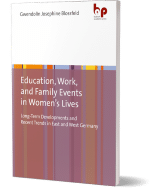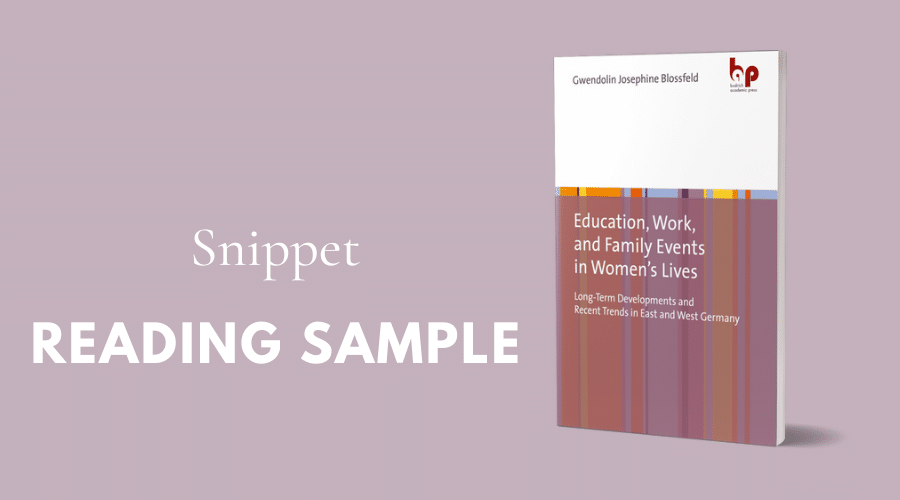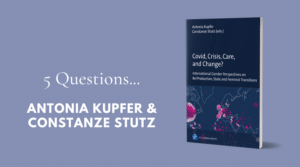Education, Work, and Family Events in Women’s Lives. Long-Term Developments and Recent Trends in East and West Germany
by Gwendolin Josephine Blossfeld
About the book
Education, Work, and Family Events in Women’s Lives investigates how educational expansion, the trend towards the service society and the German unification affect East and West German women’s life courses and family lives. It focuses on educational enrolment, educational attainment level, labour force participation, career resources, social origin, the educational match among partners as well as historical periods and examines their consequences on women’s entry into first motherhood as well as partnership formation and dissolution processes. Using longitudinal data from the National Educational Panel Study (NEPS),multivariate methods such as event history analysis were applied. The findings suggest that women’s entry into motherhood during full-time education is highly dependent on women’s age, social origin and the policy measures in a country.
Reading sample from the Conclusion: pp. 195-199
9 Conclusion
Over the last few decades, family formation and dissolution processes have undergone remarkable changes in Germany. These developments can be described in terms of demographic transformations such as declining fertility, rising ages at first birth and first marriage, increasing rates of premarital cohabitation, as well as changing separation and divorce rates (Calot 1998; Frejka/Calot 2001b). They are associated with unprecedented shifts in social norms and values in modern societies (Beck/Beck-Gernsheim 1994; Giddens 1997; Grunow/Aisenbrey/Evertsson 2011; Lesthaeghe/Surkyn 1988; Mayer/Huinink 1990). Demographic life events are central to the lives of individuals and, in particular, to women and they are embedded in a specific institutional and historical context (Mayer 1990). Important life course decisions of individuals are often not taken in isolation, but are part of a more complex interdependence of developments in several life domains (ebd; Willekens 1999).
One of the main factors contributing to the demographic change is considered to be educational expansion. This has lengthened the time young people spend in education, is connected to a declining inequality in gender-specific participation in higher education, and has led to an increase in the average qualification level of women and men across birth cohorts (Mayer 1990). In this book, I have focused on the life courses of women in East and West Germany. From this perspective, increasing enrolment in education means that young women stay longer in a period of social immaturity and economic dependence. This not only increases women’s conflict between full-time education and having children but also delays their readiness to enter a union and to have babies. The striking gains in education by women relative to men have transformed the educational system into a marriage market and increased the likelihood that young people with similar educational attainment levels will meet and associate with each other. Women’s rising educational investments across cohorts link up with a higher female labor force participation and higher wages for women. This leads to rising costs of children and increases the conflicts women in Germany face in balancing family and professional responsibilities (Grunow 2013). Women’s higher education is also connected with an increasing autonomy and autarchy later in life, and this makes it easier for women to exit an unhappy nonmarital or marital union.
In addition, the labor market has been characterized by important developments. There has been a trend toward upskilling and tertiarization of the occupational structure (Gallie 1998; Solga/Mayer 2008) that makes it easier for qualified women to find an appropriate job and to make their own successful careers. At the same time, different forms of part-time work have expanded in the employment system, and these help women to reduce their conflict between work and family demands (Blossfeld/Hakim 1997). Finally, the general trend toward labor market flexibilization has increased the proportion of fixed-term contracts among the young generation and particularly among higher qualified men and women (Buchholz 2008). This often results in an additional delay when entering long-term binding commitments such as a union or parenthood.
Compared to other industrialized societies, Germany has experienced a unique development through its separation into a socialist and a capitalist state after World War II and its unification after the fall of the Berlin Wall. Whereas East and West Germany share the same history before this division, the lives of East and West German women differed greatly during the period of separation. The socialist state in East Germany supported mothers’ educational enrolment and full-time employment by providing extensive child care as well as financial and institutional support. The West German welfare state, in contrast, privileged the more traditional “male breadwinner” and “secondary earner” marriage through tax incentives and only moderate childcare provision for mothers (Obertreis 1986; Trappe 1995; Trappe/Rosenfeld 2000). The fall of the Berlin Wall resulted in unusual turbulences and unexpected continuities in the transformation of life courses, particularly in East Germany (Diewald/Goedicke/Mayer 2006b; Mayer 1990). Women and men in the East experienced a difficult phase of transition from socialism to capitalism accompanied by an unprecedented level of economic and social uncertainty that influenced family events in the life course such as marriage, childbirth, and divorce.
This concluding chapter wraps up and discusses the findings of the preceding seven empirical chapters. First, I summarize the major results of the empirical analyses. Second, I reflect upon the implications of these findings. Finally, I debate the limitations of this study and offer various suggestions for future research.
9.1 Central Findings
Chapter 2 focused on women’s sequences of different partnership states over the early life course, the change in the timing of entry into marriage, as well as the relationship between living arrangements and entry into first motherhood for selected birth cohorts in East and West Germany. The descriptive analysis shows that East and West German women have delayed their entry into marriage over successive birth cohorts, leading to an overall lower proportion of ever married women. At the same time, the proportion of German women who remain single until the age of 35 has been stable over successive birth cohorts. What has changed in Germany are women’s partnership formation patterns. Cohabitation as a first type of union has gained in importance, whereas the proportion of women who enter straight into marriage has strongly declined. East German women generally start their families at younger ages. Nowadays, the vast majority of East and West German women first enter cohabitation. Nonetheless, marriage still seems to be important to women in Germany, because the majority of cohabiting women transform their nonmarital unions into marriages. Hence, cohabitation is not yet an alternative to marriage for most young people in East and West Germany. It has become more of an additional stage in the marriage process.
Union formation processes. Using event history models, I then studied the impact of place and historical time, macrostructural insecurity, education, and the birth of children on women’s entry into a first union (cohabitation vs. marriage) and the transition from cohabitation to marriage (vs. separation) in more detail. In East and West Germany, cohabitation has become increasingly wide-spread as a first form of living arrangement both across cohorts and across historical periods. Whereas the rate of separation of cohabitation has not changed across decades, the transition rate from cohabitation to marriage has declined over historical time. This means that cohabitations are becoming increasingly common in both the East and the West, but have not yet reached the state of an alternative to marriage, particularly in West Germany. When I study the educational matches in cohabitation in more detail, I see that women’s downward cohabitation has been stable across decades. The increase in cohabitation has therefore been based on homophilous and upward cohabitations of women regarding the educational attainment levels of their male partners.
My analysis shows that many young people choose cohabitation as a more flexible living arrangement in a period of social immaturity and life course uncertainty—for example, while participating in education. Educational enrolment itself leads to a postponement of women’s entry into a first union—be it cohabitation or marriage. However, if women start a union while enrolled in education, they will enter cohabitation more often than marriage. Hence, the rising age at entry into marriage has been offset at least partly by an increasing duration of premarital cohabitation. A woman’s educational attainment level has no effect on entry into first marriage, but it does increase the rate of entry into cohabitation. With women’s increasing educational attainment level, these cohabitations then also turn into marriages more often and they dissolve less often. If women are better educated than their partner, cohabitations dissolve more often and turn into marriages less often. This means that the diffusion of cohabitation acts, to some extent, as a structural filter that decreases the rate of marriage when women have a higher educational attainment level than their partner. The educational match of the parents and, therefore, the mother’s role model also has a strong effect on the daughter’s educational assortative mating. Mothers with a less educated partner have daughters who are also more likely to cohabit with a less educated partner. In contrast, mothers who are in a more traditional union in which the father has a higher education than the mother also significantly more often have daughters who marry a better educated partner.
When women are expecting a child, the marriage rate is higher than the rate of cohabitation in both East and West Germany, independent of the educational match between partners. The biggest difference between East and West German women can be found in the role of premarital conception and the prevalence of childbearing out-of-wedlock. West German women experience a strong increase of the rate of entry into marriage when they become pregnant; this is true for both single women and cohabiting women. But this effect is much weaker for East German women and suggests that East Germans see cohabitation much more often as an alternative to marriage. This erosion of traditional marriage norms in East Germany is also reflected by the stabilizing effect of the presence of a child on cohabitation. In other words, the importance of marrying to “legitimize” a birth has become much less compelling in the East. Macrostructural insecurity, in terms of high unemployment rates, has a delaying effect on women’s entry into marriage, though I have been able to show that this is true only for homogamous and upward marriages.
Fertility processes. In Chapters 6 and 7, I have analyzed women’s fertility behavior in East and West Germany. Although Germany is faced with a low fertility level, the majority of women under study have entered motherhood. Becoming a mother in Germany is influenced strongly by two competing societal norms: first, a normative sequencing norm that women should first finish education and enter the job market before having their first child; and second, an age norm representing societal expectations about the appropriate age to start having children. My difference-in-differences analysis of women’s entry into motherhood during educational enrolment demonstrated that the conflict between the sequencing norm and the age norm depends on a woman’s age and social origin along with the availability of pronatalist state support. Social origin has a negative effect on women’s entry into motherhood only when women are still participating in education. Women from higher social origins want to maintain their class position from one generation to the next and do not want to risk their educational career through entry into motherhood.
The description based on a cross-sectional perspective seems to confirm the predictions of the economic theory of the family that women with higher educational attainment levels have lower fertility. However, my longitudinal analysis did not find any negative effect of educational investments per se on entry into first motherhood. Instead, it is only that women with a higher educational attainment level only participate longer in education and therefore tend to postpone first motherhood. Hence, it is not educational investment that is in a permanent conflict with fertility over the life course of women. It is women’s extended educational participation that is simply leading to a temporary delay of entry into first motherhood.
My results support the economic theory of the family only when women are able to turn their educational investments into career resources through full-time employment. Better job quality and the status of full-time employment clearly increase women’s opportunity costs to have a first child and therefore lead to a lower rate of entry into motherhood. What seems to be much more important for the fertility decline is that women with only a temporary contract are less likely to enter first motherhood due to their higher job insecurity. These women do not want to endanger their future employment opportunities through motherhood. Hence, alongside the increased opportunity costs, the delay in fertility in Germany also seems to be the result of the flexibilization of the labor market with the rapidly rising proportion of fixed-term contracts for young women and their partners.
***
Would you like to read more?
 Order via our webshop
Order via our webshop
by Gwendolin Josephine Blossfeld

